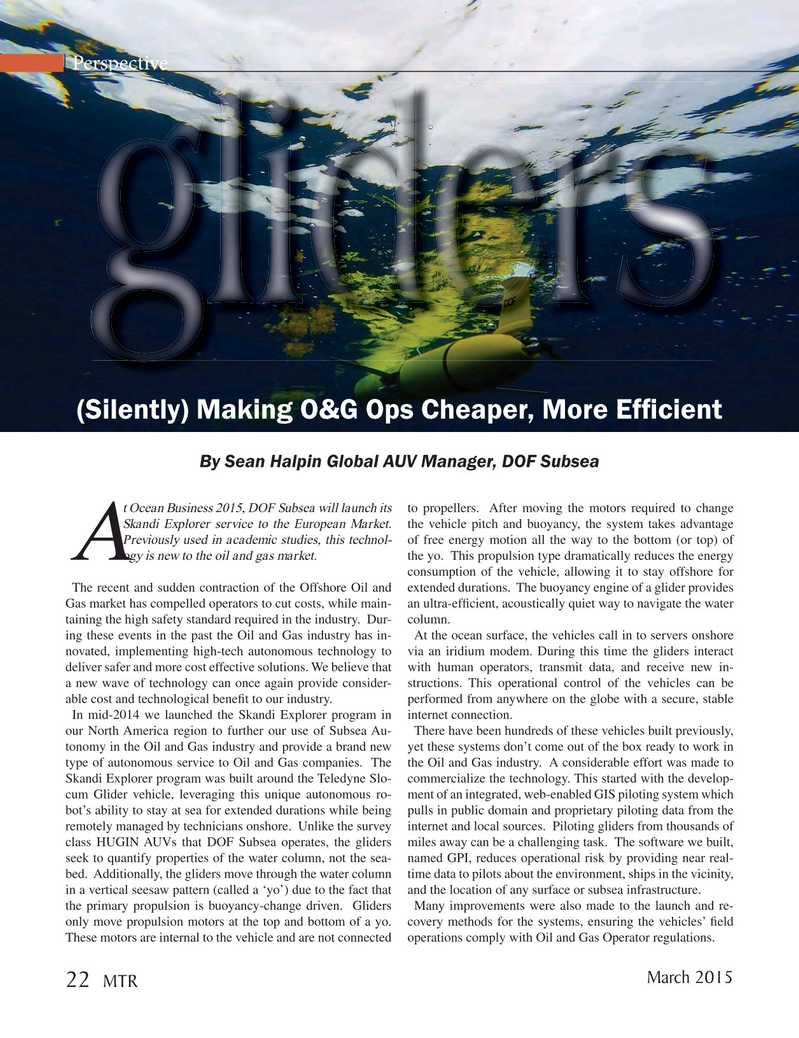
Page 22: of Marine Technology Magazine (March 2015)
Oceanographic Instrumentation: Measurement, Process & Analysis
Read this page in Pdf, Flash or Html5 edition of March 2015 Marine Technology Magazine
Perspective (Silently) Making O&G Ops Cheaper, More Ef? cient(Silently) Making O&G Ops Cheaper, More Ef? cient
By Sean Halpin Global AUV Manager, DOF Subsea t Ocean Business 2015, DOF Subsea will launch its to propellers. After moving the motors required to change
Skandi Explorer service to the European Market. the vehicle pitch and buoyancy, the system takes advantage
Previously used in academic studies, this technol- of free energy motion all the way to the bottom (or top) of
Aogy is new to the oil and gas market. the yo. This propulsion type dramatically reduces the energy consumption of the vehicle, allowing it to stay offshore for
The recent and sudden contraction of the Offshore Oil and extended durations. The buoyancy engine of a glider provides
Gas market has compelled operators to cut costs, while main- an ultra-ef? cient, acoustically quiet way to navigate the water taining the high safety standard required in the industry. Dur- column. ing these events in the past the Oil and Gas industry has in- At the ocean surface, the vehicles call in to servers onshore novated, implementing high-tech autonomous technology to via an iridium modem. During this time the gliders interact deliver safer and more cost effective solutions. We believe that with human operators, transmit data, and receive new in- a new wave of technology can once again provide consider- structions. This operational control of the vehicles can be able cost and technological bene? t to our industry. performed from anywhere on the globe with a secure, stable
In mid-2014 we launched the Skandi Explorer program in internet connection.
our North America region to further our use of Subsea Au- There have been hundreds of these vehicles built previously, tonomy in the Oil and Gas industry and provide a brand new yet these systems don’t come out of the box ready to work in type of autonomous service to Oil and Gas companies. The the Oil and Gas industry. A considerable effort was made to
Skandi Explorer program was built around the Teledyne Slo- commercialize the technology. This started with the develop- cum Glider vehicle, leveraging this unique autonomous ro- ment of an integrated, web-enabled GIS piloting system which bot’s ability to stay at sea for extended durations while being pulls in public domain and proprietary piloting data from the remotely managed by technicians onshore. Unlike the survey internet and local sources. Piloting gliders from thousands of class HUGIN AUVs that DOF Subsea operates, the gliders miles away can be a challenging task. The software we built, seek to quantify properties of the water column, not the sea- named GPI, reduces operational risk by providing near real- bed. Additionally, the gliders move through the water column time data to pilots about the environment, ships in the vicinity, in a vertical seesaw pattern (called a ‘yo’) due to the fact that and the location of any surface or subsea infrastructure. the primary propulsion is buoyancy-change driven. Gliders Many improvements were also made to the launch and re- only move propulsion motors at the top and bottom of a yo. covery methods for the systems, ensuring the vehicles’ ? eld
These motors are internal to the vehicle and are not connected operations comply with Oil and Gas Operator regulations.
March 2015 22
MTR
MTR #2 (18-33).indd 22 MTR #2 (18-33).indd 22 3/8/2015 2:10:50 PM3/8/2015 2:10:50 PM

 21
21

 23
23
